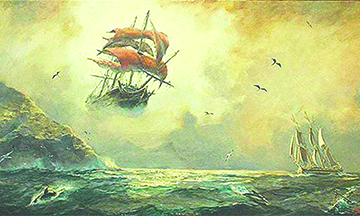
El Holandés Errante
The Flying Dutchman
El Holandés Errante era un barco, bautizado así por su capitán Bernard Fokke, nacido en La Haya, Holanda.
Gran marino e inventor, era capaz de realizar viajes a enorme velocidad, con tecnología creada por él, a raíz de esto, las habladurías sostenían que tenía un pacto con el diablo.
El buque El Holandés Errante desapareció en 1680, al ser sorprendido por una gran tormenta en el Cabo de Buena Esperanza y, quienes lo conocían, dedujeron que por haber pactado con el diablo, Dios lo castigó por toda la eternidad, con esta palabras… “Nunca llegarás a puerto ni conocerás el descanso”.
Dicen que la respuesta de Bernard Fokke fue… “Desafío al poder de Dios a detener el curso de mi destino y mi exitosa carrera. Nada ni nadie despertará mi temor. Aunque tenga que surcar los mares basta el día del juicio”. Y acto seguido se amarró al timón, entonando canciones sacrílegas
Malos Augurios
A partir de allí, el Holandés Errante, se transformó en sinónimo de malos augurios, desastre y muerte. Los marineros y pescadores aun hoy sostenían que ver al buque fantasma en alta mar, atrae el infortunio, los barcos encallan o quedaban varados por su culpa.
Incluso sostiene que el Holandés Errante anuncia su llegada, agriando el vino y pudriendo el agua; llevando a la tripulación a la hambruna.
Nada puede borrar la idea de la mente de los marineros; de los holandeses paso a los marineros ingleses, europeos, hindúes y orientales, muchos de estos creen realmente que vieron esta aparición.
El 11 de julio de 1881, a las 4 am., frente a la costa de Australia, fue el primer avistamiento registrado, “siendo la noche clara y la mar en calma, trece personas vieron como un buque aparecía en el horizonte para luego desaparecer repentinamente, sin explicación alguna”..
Del mito a la literatura, la música y el cine.
Esta historia, difundida de boca en boca a lo largo de más de un siglo, es la que inspiró la leyenda que todavía sigue circulando, que se supone tiene como base una historia real, aunque deformada por la imaginación y el tiempo.
La primera referencia impresa aparece en “Viajes” de John Mac Donald, publicado en 1790.
En 1795 se publica Voyager atribuido a George Barrington, donde hace referencia a la historia.
En 1804, Thomas Moore sitúa el barco en el Atlántico Norte, cuando dice “Deslizándose rápido, un sombrío ladrar / Sus velas están llenas, aunque el viento está quieto, / Y no sopla ni un soplo para llenar sus velas”
En 1812, Sir Walter Scott en su obra Rokeby explica que, “la aparición del barco es considerada por los marineros como el peor de los presagios posibles”.
En 1821, una revista británica dando pie, recopila un resumen de la historia, de la tradición oral
En 1832 el escritor August Jal, de origen escandinavo, publicada la novela “El Holandés Errante”, en base a los trabajos anteriores.
El novelista y marino Frederick Marryat, de origen inglés y destacado en escrituras marinas, publica en 1847, la novela The Phantom Ship, El Barco Fantasma, en base al relato de August Jal, pero cambia el nombre del Capitán por el de Vander Decken.
En 1848, Richard Wagner inmortalizaría la historia en la ópera Der Fliegende Holländer (El Holandés Errante o El Buque Fantasma).
En 1998 se estrena la película Flying Dutchman (El Holandés Errante).
Incluso personajes para niños, como Bol Esponja, toma la idea del Holandés Errante, para alguno de sus capítulos.
The Flying Dutchman
The Flying Dutchman was a ship, named after its captain Bernard Fokke, born in The Hague, Holland.
A great sailor and inventor, he was capable of traveling at enormous speed, with technology created by him, as a result of this, gossip maintained that he had a pact with the devil.
The ship The Flying Dutchman disappeared in 1680, when it was surprised by a great storm in the Cape of Good Hope and, those who knew it, deduced that for having agreed with the devil, God punished him for all eternity, with these words… “ You will never reach port or know rest.
They say that Bernard Fokke’s response was… “I defy the power of God to stop the course of my destiny and my successful career. Nothing and no one will arouse my fear. Even if I have to sail the seas, the day of judgment is enough”. And thereupon he strapped himself to the helm, singing sacrilegious songs
Bad omens
From there, the Flying Dutchman became synonymous with bad omens, disaster and death. Sailors and fishermen even today maintained that seeing the ghost ship on the high seas attracts misfortune, ships run aground or were stranded because of it.
He even maintains that the Flying Dutchman heralds his arrival, turning wine sour and water rotting; leading the crew to starvation.
Nothing can erase the idea from the minds of the sailors; from the Dutch it passed to the English, European, Hindu and Oriental sailors, many of whom actually believe that they saw this apparition.
On July 11, 1881, at 4 am, off the coast of Australia, it was the first recorded sighting, “being the night clear and the sea calm, thirteen people saw how a ship appeared on the horizon and then disappeared suddenly, without any explanation”.
From myth to literature music and cinema.
This story, spread by word of mouth for more than a century, is what inspired the legend that is still circulating, which is supposed to be based on a true story, although distorted by imagination and time.
The first printed reference appears in John MacDonald’s “Travels”, published in 1790.
In 1795 Voyager attributed to George Barrington was published, where he made reference to the story.
In 1804, Thomas Moore places the ship in the North Atlantic, when he says “Gliding fast, a grim bark / Her sails are full, though the wind is still, / And there is not a breath to fill her sails.”
In 1812, Sir Walter Scott in his work Rokeby explains that, “the appearance of the ship is considered by sailors as the worst possible omen.”
In 1821, a British magazine giving rise to, compiles a summary of the history, from the oral tradition
In 1832 the writer August Jal, of Scandinavian origin, published the novel “The Flying Dutchman”, based on previous works. A2
The novelist and sailor Frederick Marryat, of English origin and prominent in marine writings, published in 1847, the novel The Phantom Ship, based on the story by August Jal, but changed the Captain’s name to Vander Decken.
In 1848, Richard Wagner would immortalize the story in the opera Der Fliegende Holländer (The Flying Dutchman or The Ghost Ship).
In 1998 the film Flying Dutchman (The Flying Dutchman) was released.
Even characters for children, such as Bol Esponja, take the idea of the Flying Dutchman for some of its chapters.
























